Batman Vengeance Preview
We take an in depth look at Ubi Soft's upcoming Batman title
Generally, developers and publishers have taken a rather direct approach to superhero-based games--the subject material is commonly taken literally, and the games are meant for younger audiences. However, with Batman: Vengeance Ubi Soft seems to be challenging those conventions, as the game shares the decidedly gritty atmosphere of the film-noir-style animated series, both in terms of visuals and gameplay. Batman: Vengeance is an inherently dark game, simply because it takes place completely at night. But in the game, ambient environmental effects such as the scorched crimson skies above Gotham City, neoclassical architecture, and the generous use of real-time shadows, combined with general production elements such as a twisted plot and mature voice acting, help further evoke an innately enigmatic experience. "We wanted to do justice to the license, and we treated it in such a way that people would be able to get into this dark world and still have a lot of fun," explains Reid Schneider, the game's producer at Ubi Soft's Montreal studio.
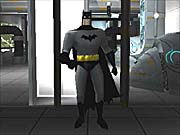
Throughout the game's development, the Batman: Vengeance development team has paid close attention to the game's story and presentation. The gameplay is enveloped by a thick veil of plot twists and story development, and over 30 minutes of real-time cutscenes and just under 10 minutes of prerendered cinematics stylistically tell this latest tale of Batman's continuing adventures. "We were able to work directly with the editors at DC Comics in order to craft the storyline," Schneider reveals. "It was very important for us to have a really, really great storyline so that it wasn't just a run-of-the-mill story where Batman had to overcome a couple of enemies, triumph, and save Gotham. We wanted to create a story where there were a lot of surprises." A quick synopsis of some of the game's plot gives a clearer picture of the developers' intentions.
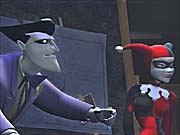
In the early stages of the game, Batman faces off against his mortal enemy, The Joker, who has kidnapped a mysterious woman. While Batman is in the process of saving the woman, Mr. Freeze and Poison Ivy enter the scene, and Batman is framed for an attack on Commissioner Gordon. All of these events are intertwined in the game's story, which should have its share of shocking revelations and surprise plot twists. "We wanted some bad things to happen to Batman; we wanted him to be in peril," continues Schneider. "We also wanted characters to die, or at least to create the illusion that characters had died. All of that was really important to us. So when we started developing the game we created the storyline and then built the gameplay and the game levels in synergy with the story--it was a new way of developing a game for us."
Adding further authenticity to the game is a professional voice cast, lifted directly from the animated television show. Most of the voice actors and actresses from the show, including Mark Hammil's Joker, Kevin Conroy's Batman, and Tara Strong's Batgirl, made it into the game. For anyone familiar with the animated series, the game's voices will sound just like they do in the show.
With so much attention being paid to the presentation and story, you might assume that the developers skimped in the gameplay department. At this point, such doesn't seem to be the case. The gameplay is rather robust, and it combines elements of exploration, puzzle solving, boss encounters, and hand-to-hand and weapons-based combat. Additionally, there are a handful of driving and shooting levels, where Batman assumes control of the batmobile and the batplane, respectively. Still, much of the gameplay takes place on the rooftops of Gotham City, in alleyways, and inside office buildings and apartments. At his command, Batman has a variety of moves and gadgets. The X button on the PlayStation 2 controller makes Batman jump--press it again and he can glide for short periods of time using his cape. When engaging an enemy, which occurs on a 2D plane like in a fighting game, the X button is also used to kick, while the square button executes a series of punches. With the circle button you can draw Batman's cape over him for defense--the cape has its own life meter, which depletes as Batman is hit. Finally, the triangle button is the general action button. It can be used to pick up objects, open doors, and even walk stealthily along walls. In terms of the shoulder buttons, R1 reorients the camera to a behind-the-back position, R2 is used to call up the items menu on the fly, and L1 can be used, in certain situations, as the batcommunicator to Batgirl, who remains back at the batcave for most of the game.
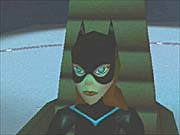
The latest build shown at Ubi Soft's Gamers Week was eons ahead of the early build we've had for several weeks, in terms of control responsiveness and general gameplay feel. Batman responded to the subtlest movement of the analog stick, and punches and kicks could be executed with ease. While using a gadget, which is done from a first-person perspective in the game, Batman is mobile using the left analog, and the right analog is used to control the target. Familiar gadgets such as the batarang, batgrapple, batlauncher, and scope are in the game--there are 11 gadgets listed at the game's onset. Going beyond the general arsenal of moves and weapons Batman: Vengeance also features so-called power moves. These are akin to finishing moves in fighting games. Power moves are accrued by earning points in the game and can be performed using a variety of button combinations. A power move is executed while Batman is engaged with an enemy and is shown through complex preset animation sequences. For example, during one sequence, we pressed the appropriate combinations for one of the early power moves and watched Batman kick an enemy, jump over him, and perform an uppercut to finish him off, all in one scripted sequence.
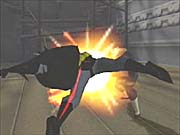
The game involves a variety of complex moves, but through it all the animation remains ultrasmooth. This is especially surprising considering that the development team hand-animated all the movement in the game, rather than using motion-capture technology. According to Schneider, it would be almost impossible to capture Batman's exaggerated and highly animated movements with the use of motion capture. "In order to catch the feel of Batman, it was important not to motion-capture and do every animation by hand," he explains. "Batman himself has over 500 animations. We wanted to stick with a lot of superhero qualities." The true sense of movement is apparent down to the actual facial animations and even Batman's cape. Every character face in the game is individually animated, and every character displays emotion through facial expressions, depending on the situation. The cape itself is designed as an independent actor that is attached to Batman's back. It can react differently, depending on Batman's movements. The cape has its own morph targets, and it can react to wind effects and any of the other forces that Batman encounters. In fact, self-animating the cape is such an extensive endeavor that an engineer has been working solely on the cape animation for a little more than ten months--its ultimate realization came through the collaborative effort of the animation and engineering teams. That is exactly the type of attention to detail that the development team is instilling in the game, in hopes of creating a product that closely mirrors the team's visions and goals for Batman: Vengeance.
The soundtrack in the game is fully orchestrated and created by Sean Clement, who has composed music for a variety of television shows, including Fox's Buffy the Vampire Slayer. More than 100 minutes of music, with a decidedly moody tone, will be featured in the game, and as mentioned previously, all of the cutscenes will be accompanied by full voice acting. Naturally, each of the stages has its own ambient music, although it is much more understated when compared to the score used for the game's cutscenes.
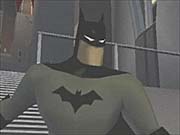
Batman: Vengeance has been in development for more than two years. Although the development team is highly concerned with matching the dark art-deco tone of the television show in the game's presentation and visuals, there will be 10 to 12 hours of actual gameplay, spanning a variety of environments in and around Gotham City. Ubi Soft hopes to follow the precedent set forth by Neversoft's Spider-Man game for the PlayStation by creating a mature superhero game with a challenging gameplay system and an intriguing plot. Judging from our hands-on experience with the latest version of the game, Ubi Soft is taking the appropriate steps necessary to realize those goals. Batman: Vengeance is currently in the final debugging stages and should hit store shelves in October.
Got a news tip or want to contact us directly? Email news@gamespot.com
Join the conversation